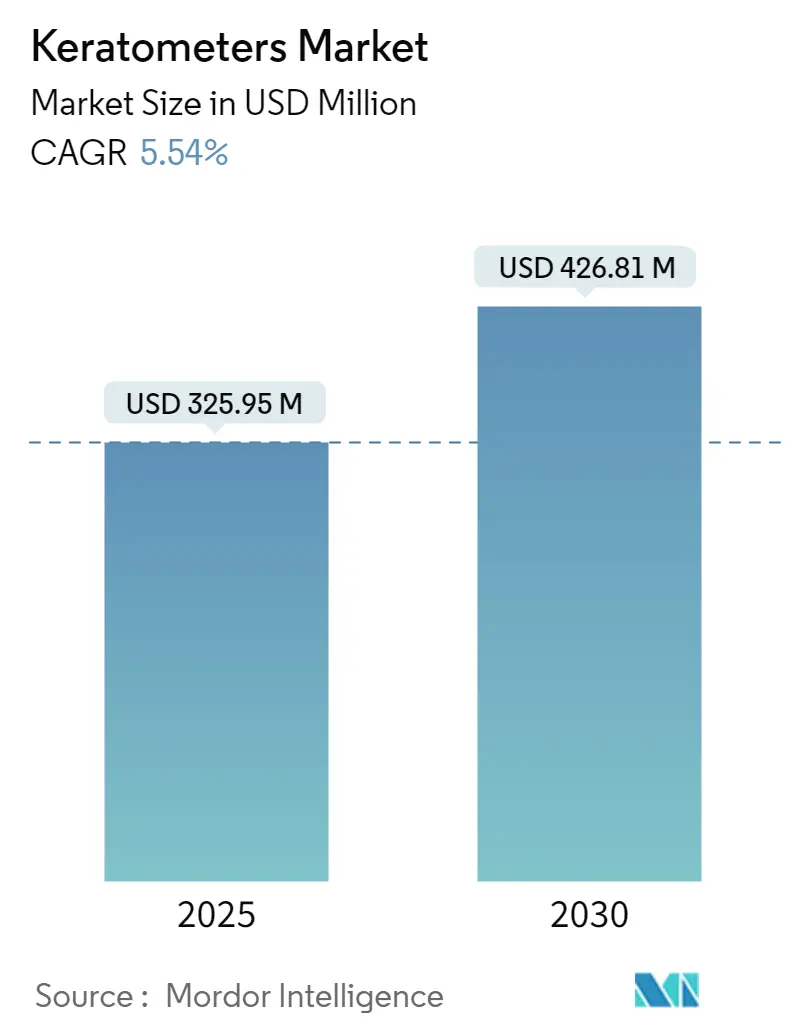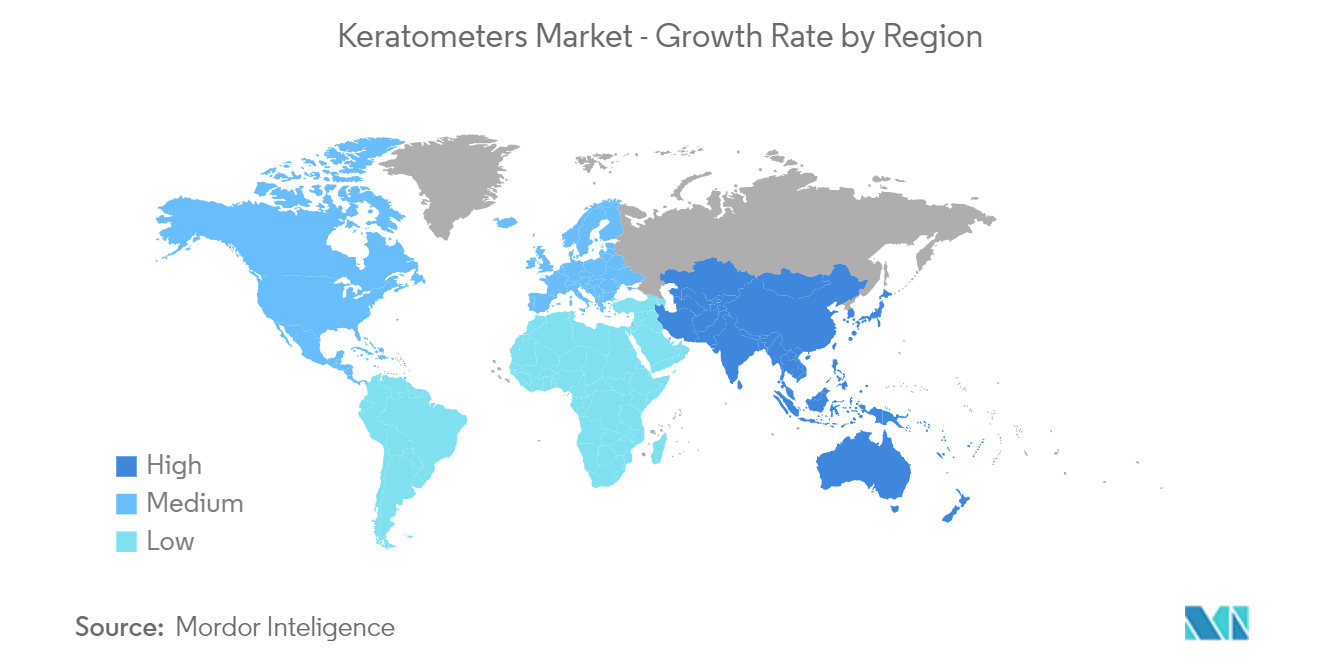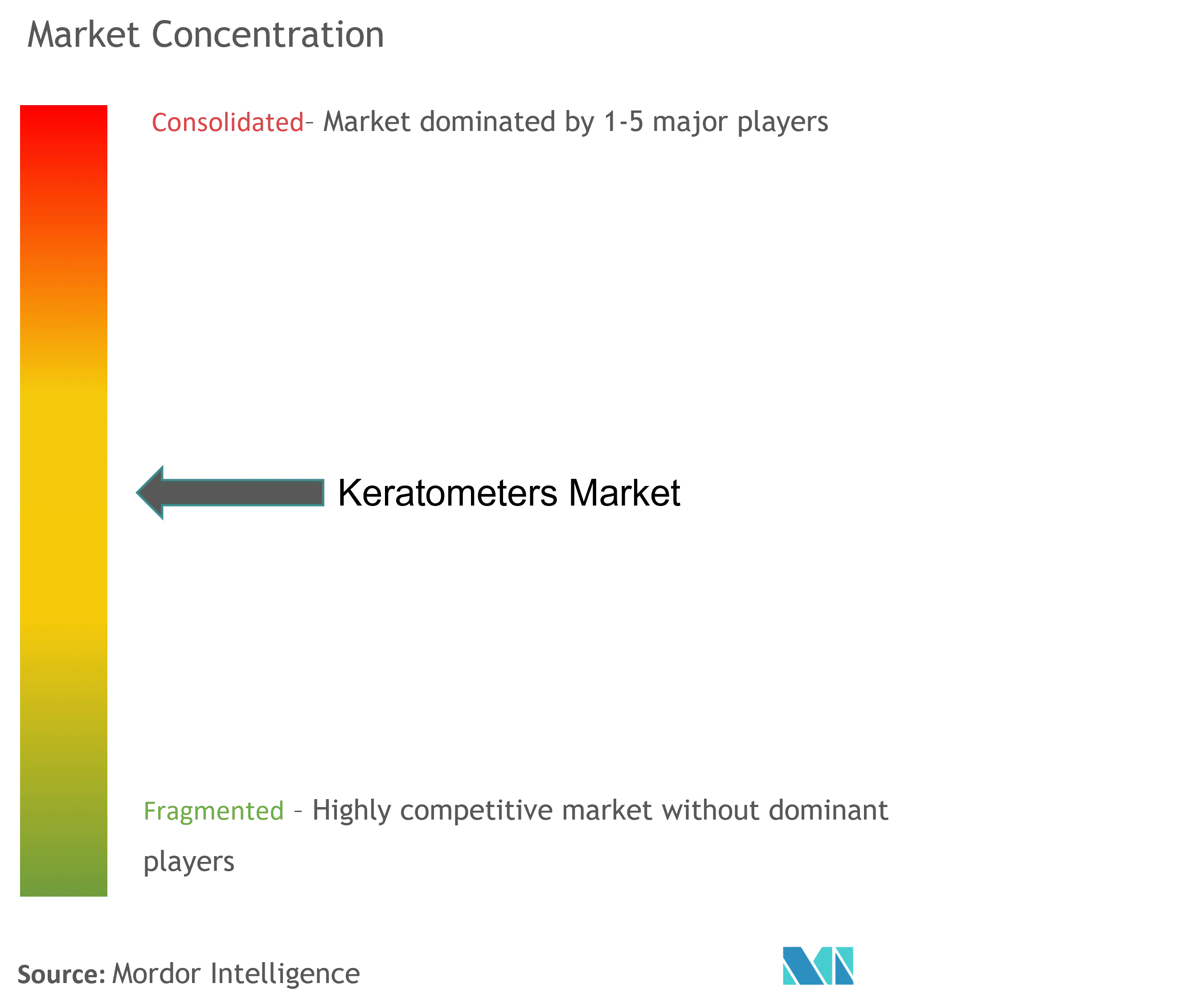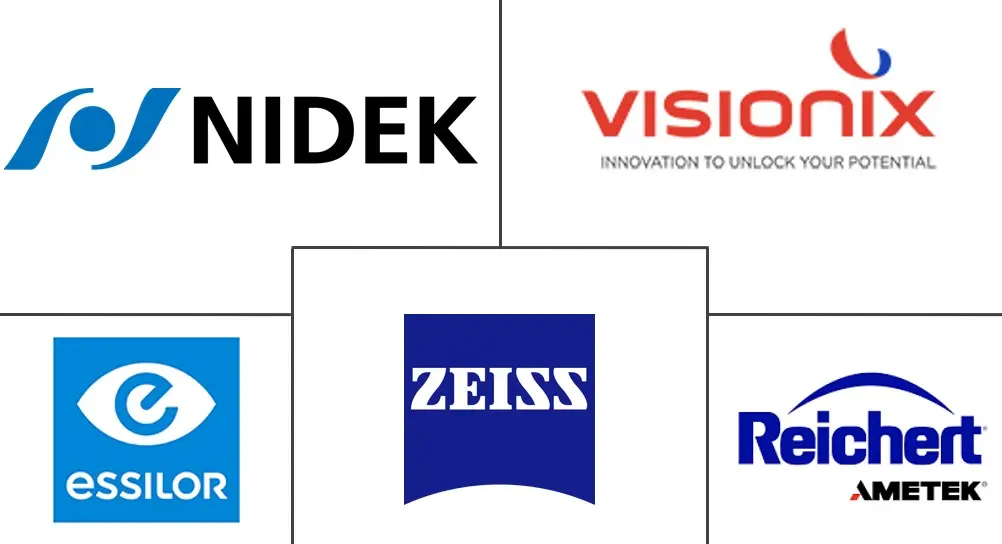Keratometers Market Size and Share

Keratometers Market Analysis by Mordor Intelligence
The Keratometers Market size is estimated at USD 325.95 million in 2025, and is expected to reach USD 426.81 million by 2030, at a CAGR of 5.54% during the forecast period (2025-2030).
The COVID-19 pandemic disrupted the treatment and diagnostic activities of diseases other than COVID-19. It impacted the treatment procedures and supply chain of pharmaceuticals and medical devices worldwide, adversely impacting the studied market. For instance, according to the Carl Zeiss annual report 2022, the revenue in the ophthalmic devices strategic business unit (SBU), including keratometers, decreased by -7.3% during the pandemic. However, the revenue from the ophthalmic devices strategic business unit increased by 17% in FY2022. It shows the declined sales revenue of ophthalmic devices like keratometers during the pandemic, which recovered due to a resumed supply chain and diagnostic activities in the healthcare facilities.
The factors driving the market include the increasing burden of eye disorders and growing investments, funds, and grants. The high burden of eye disorders increases the demand for keratometers, which is expected to grow significantly. For instance, as per the report published by InSight Vision Center in December 2021, 23% of infants aged 6 to 12 months would include common astigmatism. Similarly, according to the October 2022 report of the WHO, about 2.2 billion people around the world suffer from near or distant vision impairment, of which approximately 1 billion cases of vision impairment can be prevented. It shows the high burden of the cases of vision impairment. It is expected to include a high demand for the diagnosis using keratometers and likely boost the market over the study period.
Furthermore, the new strategies and initiatives by the market players are expected to significantly impact the market. For instance, in May 2021, ZEISS expanded its national coverage in the United States for its Industrial Quality & Research segment by acquiring Capture 3D. With this acquisition, customers benefitted from a seamless, integrated experience to get the best measuring solutions, and it is expected to propel the market over the stud period.
However, the need for primary infrastructure for eye-related diseases in underdeveloped and developing countries hampers overall market growth.
Global Keratometers Market Trends and Insights
Hospitals are Expected to Hold a Significant Market Share Over the Forecast Period
The increasing number of hospitals is the primary factor for market growth. The number of hospitals is growing at a steady pace in various countries like the United States and Mexico. For instance, according to the American Hospital Association 2022 report, there are 6,093 hospitals in the United States. However, the Definitive Healthcare HospitalView product tracks 7,308 active United States hospitals as of March 2022. These hospital facilities are curated from 40 public, private, and proprietary sources. Increasing investment is another factor for market growth.
The report published by India Brand Equity Foundation in December 2021 stated that Foreign Direct Investment (FDI) inflows for the drugs and pharmaceuticals sector stood at USD 19.19 billion, according to the data released by the Department for Promotion of Industry and Internal Trade (DPIIT). FDI inflows in sectors such as hospitals, diagnostic centers, and medical and surgical appliances stood at USD 7.73 billion and USD 2.35 billion, respectively.
The same source stated that the Indian government plans to introduce a credit incentive program worth INR 500 billion (USD 6.8 billion) to boost the country's healthcare infrastructure. The program will allow firms to leverage the fund to expand hospital capacity or medical supplies, with the government acting as a guarantor. Such initiatives and investments would increase the end-user facilities by adopting various medical devices, including keratometers. Hence, the factors mentioned above are expected to drive the growth of the studied segment during the forecast period.

North America is Expected to Hold the Significant Share in the Market Over the Forecast Period
The North American region is expected to hold a significant market share over the forecast period. Factors such as investments, increasing eye disorders, and research studies will likely increase market growth. According to the NCHS at CDC in March 2023, the research funding for eye disease and disorders of vision was USD 1,070 million in 2021, which was increased to USD 1,097 million in 2022 and is estimated to be USD 1,163 million in 2023. It shows the increasing research funding on eye disease and vision disorders, which is expected to significantly impact keratometer usage, propelling the market's growth over the forecast period.
Keratometry measures the cornea's curvature to calculate corneal astigmatism along with posterior corneal astigmatism and posterior and anterior crystalline lens astigmatism, which is minimal in many cases. Astigmatism is the most frequent ammetropia. Increasing prevalence will increase the demand for keratometers, which is expected to boost the market's growth in the region. For instance, as per the report published by NVISION Eye Centers in December 2022, astigmatism occurs in about one out of every three people in the United States. In addition, farsightedness occurs in about 8.4% of the population over 40, and nearsightedness occurs in about 23.9% of the population over 40 years old. It shows the high burden of vision impairment, which increases keratometers' usage and propels market growth.

Competitive Landscape
The market is moderately consolidated and consists of several major players. The companies are implementing certain strategic initiatives, such as mergers, new product launches, acquisitions, and partnerships, that help them strengthen their market positions. Further, the increase in research and development activities initiated by the key players also favors market growth. Some companies currently dominating the market are Carl Zeiss AG, Essilor, Visionix (Luneau Technology), Reichert, Inc., and NIDEK CO., LTD.
Keratometers Industry Leaders
-
Carl Zeiss AG
-
Essilor
-
NIDEK CO., LTD
-
Visionix (Luneau Technology)
-
Reichert, Inc
- *Disclaimer: Major Players sorted in no particular order

Recent Industry Developments
- June 2023: EssilorLuxottica and the World Society of Paediatric Ophthalmology and Strabismus collaborated to advance knowledge and education of myopia management globally. This collaboration is expected to contribute to educating further and help eye care professionals successfully integrate myopia management in practice and guide their patients on how to manage their myopia.
- March 2023: WaveFront Dynamics Inc., an ophthalmic medical device company, launched its dynamic aberrometry measurement system, the WaveDyn Vision Analyzer, which is also used for keratometry.
Global Keratometers Market Report Scope
As per the scope, a keratometer (also called an ophthalmometer) is a device used to measure the curvature of the cornea's frontal surface. The Keratometers Market is segmented by type (stationary type keratometers and portable type keratometers), end user (hospitals, eye clinics, and others), and geography (North America, Europe, Asia-Pacific, Middle East, and Africa, and South America). The report also covers the estimated market sizes and trends for 17 countries across major regions globally. The report offers the value (USD) for the above segments.
| Stationary Type Keratometers |
| Portable Type Keratometers |
| Hospitals |
| Eye Clinics |
| Others |
| North America | United States |
| Canada | |
| Mexico | |
| Europe | Germany |
| United Kingdom | |
| France | |
| Italy | |
| Spain | |
| Rest of Europe | |
| Asia-Pacific | China |
| Japan | |
| India | |
| Australia | |
| South Korea | |
| Rest of Asia-Pacific | |
| Middle East and Africa | GCC |
| South Africa | |
| Rest of Middle East and Africa | |
| South America | Brazil |
| Argentina | |
| Rest of South America |
| By Type | Stationary Type Keratometers | |
| Portable Type Keratometers | ||
| By End User | Hospitals | |
| Eye Clinics | ||
| Others | ||
| Geography | North America | United States |
| Canada | ||
| Mexico | ||
| Europe | Germany | |
| United Kingdom | ||
| France | ||
| Italy | ||
| Spain | ||
| Rest of Europe | ||
| Asia-Pacific | China | |
| Japan | ||
| India | ||
| Australia | ||
| South Korea | ||
| Rest of Asia-Pacific | ||
| Middle East and Africa | GCC | |
| South Africa | ||
| Rest of Middle East and Africa | ||
| South America | Brazil | |
| Argentina | ||
| Rest of South America | ||
Key Questions Answered in the Report
How big is the Keratometers Market?
The Keratometers Market size is expected to reach USD 325.95 million in 2025 and grow at a CAGR of 5.54% to reach USD 426.81 million by 2030.
What is the current Keratometers Market size?
In 2025, the Keratometers Market size is expected to reach USD 325.95 million.
Who are the key players in Keratometers Market?
Carl Zeiss AG, Essilor, NIDEK CO., LTD, Visionix (Luneau Technology) and Reichert, Inc are the major companies operating in the Keratometers Market.
Which is the fastest growing region in Keratometers Market?
Asia-Pacific is estimated to grow at the highest CAGR over the forecast period (2025-2030).
Which region has the biggest share in Keratometers Market?
In 2025, the North America accounts for the largest market share in Keratometers Market.
What years does this Keratometers Market cover, and what was the market size in 2024?
In 2024, the Keratometers Market size was estimated at USD 307.89 million. The report covers the Keratometers Market historical market size for years: 2019, 2020, 2021, 2022, 2023 and 2024. The report also forecasts the Keratometers Market size for years: 2025, 2026, 2027, 2028, 2029 and 2030.
Page last updated on:
Keratometers Market Report
Statistics for the 2025 Keratometers market share, size and revenue growth rate, created by Mordor Intelligence™ Industry Reports. Keratometers analysis includes a market forecast outlook for 2025 to 2030 and historical overview. Get a sample of this industry analysis as a free report PDF download.



